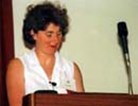Freedom of Information-- conference summary

Open access challenges us all to be "good scientific citizens"
By Fiona Godlee
Who pays for science, who profits from it, and who is it all for anyway? If a large proportion of scientific research is paid for by public money, if a key motivation for scientists is to communicate their work to others, and if the new technology allows free access to information, what is preventing open public access to the results of scientific research? Who but the publishers benefit from a system that expects scientists to submit their work free to journals and then expects them and everyone else to pay to access it? Pat Brown (Stanford University) spoke for many at a meeting in New York last week when he asked, "If all journals disappeared tomorrow, would science just stop?"
 In a challenging finale to the meeting on freedom of information, organised by BioMed Central, Pat Brown called on all scientists to take back control of their work, to insist on retaining copyright, and to boycott journals that refused to make the results of primary science freely available: 'scientists must insist that scientific research is free, untaxed by the parasites in the publishing world.'
In a challenging finale to the meeting on freedom of information, organised by BioMed Central, Pat Brown called on all scientists to take back control of their work, to insist on retaining copyright, and to boycott journals that refused to make the results of primary science freely available: 'scientists must insist that scientific research is free, untaxed by the parasites in the publishing world.'
Opening the meeting, Harold Varmus, director of the Memorial Sloan-Kettering Cancer Center (New York) and one of the architects of PubMed Central—the NIH's open access repository of peer reviewed material—suggested that the scientific community should test different models of open access during what he called this "transfer period." There was an assumption, he said, that those who needed to access information could already do so. In fact, most people in developing countries, as well as many in the developed world remained "disenfranchised."
Open access did not mean loss of quality, he said. Pieter Bolman of Academic Press (San Diego) disagreed. Speaking for commercial scientific publishers, he said that peer review was expensive, and that only by charging people to access material could publishers, on behalf of society as a whole, ensure the quality of scientific information. But others suggested that, far from compromising quality, open access had the potential to improve it. Peer review could change from a closed, poorly accountable, binary event (to publish or not to publish), in which a few chosen peers take part, into an open, ongoing process, potentially involving many peers from a range of disciplines. As Paul Ginsparg of the Los Alamos National Laboratory said, "The web offers peer review at lower cost and with greater functionality."
Open access would mean "disentangling distribution of science from validation," said Paul Ginsparg, as has already happened to some extent within physics. Journals of the future would no longer be involved in distribution. Their role would be to validate science, with multiple journals able to point at a single report or dataset.
Society publishers expressed an additional concern about open access—that the useful work they do in lobbying and educating would suffer without the money they made from journals. But, said Elizabeth Marincola of the American Society of Cell Biology, resisting open access was not in the interests of the people societies were set up to serve—their members and the public. The new technology offered scope for efficiencies and diversification. Only those professional and academic societies that embraced open access would survive what she called the "Darwinian shake-up."
Setting up open access sites, such as BioMed Central, may be a crucial first step in changing the way that science is disseminated. But most speakers agreed that it would take more than setting up alternatives to change behavior. Opening the door of a rat's cage did not mean that the rat, after years of confinement, would rush to escape. Especially, said Peter Singer of the University of Toronto, since the cage was where the rat found its food and water. "For authors to be incentivized to submit their articles to the new forms of e publishing, the incentive system needs to be modified to reward this behavior—the food and water need to be moved outside the cage," he said.
This could only be achieved if granting agencies and academic institutions were prepared to stop using the status of the journal in which a paper was published to short cut their way through funding and appointment decisions. As explained by Barry Markovitz of Washington University Medical School (St. Louis) journal impact factors are anyway a poor proxy for the value of individual pieces of research.
Delegates at the meeting can have been left in little doubt that open access was on its way and would bring with it huge changes in the way science is communicated and judged. "We have to ask ourselves what it means to be a good scientific citizen," said Pat Brown. If this meant never again publishing his work in the New England Journal of Medicine for instance, he was prepared to do that. Scientists with their reputations still to make may prefer to wait for the climate to change. So the real challenge from the meeting falls on granting agencies and academic institutions, to stop penalizing authors who submit their work to open access sites, and even to insist that this is what they should do.
 About the author: Fiona Godlee is Editorial Director (Medicine) at BioMed Central (fiona@biomedcentral.com).
About the author: Fiona Godlee is Editorial Director (Medicine) at BioMed Central (fiona@biomedcentral.com).
This article is copyrighted by BioMed Central Ltd., 2000
